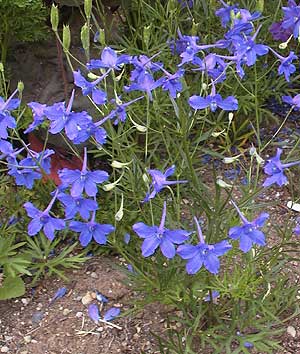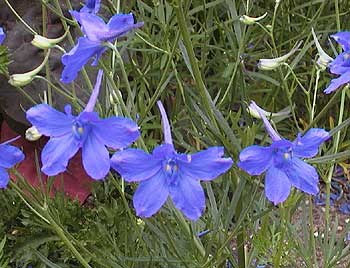Consolida chinensis 'Gentian Blue'
LARKSPUR, ANNUAL DELPHINIUM
syn. Delphinium chinensis 'Gentian Blue'
Family: Ranunculaceae
Pronounced: kon-SO-li-da chin-EN-sis
Quick Jumps
Growing Guide
Rainy Side Notes
GROWING GUIDE

Origin:
Garden.
Plant Group:
Annual.
Mature size:
Height: 12 inches (30 cm).
Width: 9-12 inches (23-30 cm).
Flowering period:
Summer.
Flowering attributes:
Delphinium-type, pure gentian blue flowers on racemes, only the upper petals are fused together, unlike the perennial delphinium petals, which are separated.
Leaf attributes:
Five-lobed, finely dissected, green leaves.
Light:
Full sun.
Soil:
Light, well-drained soil.
Feeding:
Add a complete organic fertilizer when planting.
Propagation Methods:
Sow seed in situ April to May or September to October, 1/8 inch deep, 12 inches apart. Indoors, start seed in late February to early March and transplant out into garden after hardening off after risk of frost is gone.
If you have a greenhouse or cold frame, start seeds in 3-inch pots in late summer and winter pots over until spring after risk of frost is over.
Pests and Diseases:
Susceptible to powdery mildew and fusarium diseases when plants are stressed.
Rainy Side Notes

I trialed Consolida 'Gentian Blue' as a possible cut flower and although it grew well, the stems were too short. I did use them, however, for shorter bouquets. The clear gentian blue color is stunning, and I would not hesitate to grow this as a bedding plant for the garden borders.
Larkspurs are cottage garden favorites that grow exceedingly well in our maritime Pacific Northwest climate, as long as we attend to their watering needs during our annual summer drought. The larkspurs actually prefer our milder, cooler climate. The common name, larkspur comes from the bird, lark, that has a long straight rear claw or spur. The flower is spur-shaped and resembles the claw of the bird, thus the common name larkspur.
Although some sources claim they do not transplant well, I start mine early in the greenhouse and transplant them into the garden very successfully. Perhaps larkspurs grown too long in a pot, do not transplant well. It is best to transplant them out into the garden as soon as possible after threat of frost is over.
For fresh use, cut flowers when one-third of the flowers on a raceme are open. For dried flowers, harvest when most of the flowers are opened and only 4 to 5 buds remain unopened. Foliage can remain on stem. Bundle up in small quantities and hang upside down for rapid drying at 70-80°F (21-27°C) in 18 hours for best color retention. Otherwise, air dry for 10-14 days.
Larkspurs are poisonous and may prove harmful if eaten.
Debbie Teashon
Photographed in author's garden.

Gardening for the Homebrewer: Grow and Process Plants for Making Beer, Wine, Gruit, Cider, Perry, and More
By co-authors Debbie Teashon (Rainy Side Gardeners) and Wendy Tweton
Copyright Notice | Home | Search | Annuals

